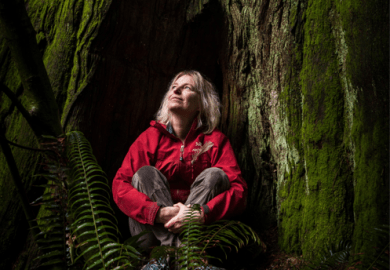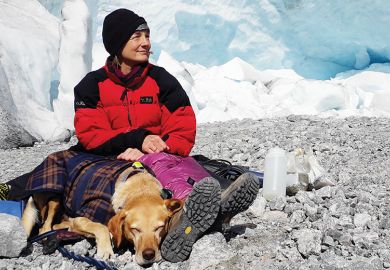Keith Thomson surveys how we came to put a date on our planet
Time, Woody Allen said, is nature's way of keeping everything from happening all at once. Alternatively, time can be seen as the necessary condition of the fact that things don't happen all at once, and a way of knowing when they actually do. Time might be thought of as having started - at the very least - with the Big Bang, continuing through the minutiae of today's life, and lasting for the imaginable and unimaginable future.
But what was before the beginning, and what comes after the end? Aristotle, for one, thought that the cosmos "neither came into being nor admits of destruction". The Judeo-Christian tradition posits both and so gives us the tradition that time is finite and that it flows in a single direction. But even in that tradition, the final Judgment Day is followed by a final, timeless eternity.
All of this raises the deeper philosophical questions. For example, does time exist if nothing is changing? Are past, present and future equally "real"? Does time flow in one direction only? What, indeed, is time? Presented with such conundrums, philosophers will seek for the deep meanings; scientists will look for something to measure and the wherewithal to do it.
The reader will not find answers to philosophical questions in Pascal Richet's book. The author does not, with one obvious exception, probe deeply into the ways of measuring time. Although it is titled A Natural History of Time , this work is really a history of geology, told as a story of ways of thinking about and discovering the age of the Earth. Richet begins with the Bible and continues through to the well-worn (but, unfortunately, now outdated) story of Lord Kelvin's estimates of age based on the rate of supposed cooling of the Earth. He ends with Arthur Holmes and the use of the rates of decay and proportions of radioactive isotopes in rocks to create the ultimate "clock".
Over 3,000 years or more, the answer to the question "How long ago did the world begin?" has steadily changed, from the comfortable range of some 2,000 to 6,000 years adduced by many scholars (not only Bishop Ussher, but starting in the 1st century AD), to the current, almost incomprehensible, 4.5 billion years for the Earth and more than 13 billion for the universe. Rehearsing this history, Richet covers a large portion of the physical sciences, but he does so as a reporter, not presenting any new ideas or viewpoints (except for his dislike for Kelvin, apparently because he made lots of money).
For more than two millennia, the only hypotheses explaining the origin of the Earth and cosmos were various creation myths. In all these myths - exemplified particularly by the biblical account in the first chapter of Genesis - everything happens, if not all at once, at least with the lightning speed appropriate for the exercise of supra-natural power. Pious attempts to reinterpret the biblical story in more modern scientific terms frequently ran into the problem of mountains and the fact that the Earth's crust is highly structured.
The Earth is, as Thomas Burnet put it in his Telluris Theoria Sacra of 1681, complex and apparently broken and disordered - "a world lying in its own rubbish". The Earth was not created flat in the biblical account. In the seventh chapter of Genesis, there are references to mountains; later, Noah's ark fetches up against one of them. Nonetheless, in some 17th and 18th-century "sacred theories", such as those of Thomas Burnet and John Woodward, the Earth was assumed to have been flat at first; mountains and all the complexities of the strata were the result of the reshaping of the world by the Flood. Such theories were still in vogue at the turn of the 19th century - for example, in John Whitehurst's Theory of the Earth of 1795. There had always been a counter-current of rational inquiry that rejected, or ignored, the Earth changing power of phenomena such as the Flood. But that left scholars either to insist that God, for some reason known only to him, had made a richly structured, "broken" Earth at Creation (the issue that Philip Henry Gosse confronted as late as 1857 in his Omphalos ) or to discover other ways by which the Earth had become changed.
In the 1660s, Robert Hooke at the Royal Society and Steno (Niels Stensen) at the Accademia del Cimento in Florence were among the first to develop the modern ideas about geology from which necessarily flowed the great antiquity of the Earth. Once it was posited that the Earth has become changed gradually and continually through natural processes of erosion and mountain-building - constantly recycling, as James Hutton finally established in 1785 - it was necessary to envisage time on a scale hitherto inconceivable. The history of the Earth had to be measured in multiples of millions, rather than a few thousands, of years.
The one case of a timekeeper that Richet discusses is the one that can measure immense periods of time - the radioactive decay of elements. Carbon-14 decays to carbon-12, giving us a way of dating organic materials to a maximum of some 50,000 years. Uranium-238 (to lead-206), thorium-232 (to lead-208), rubidium 87 (to strontium-87) and other isotopes allow us to date rocks to billions of years. The discovery of these "radiometric clocks", led by the geologist Holmes and made possible by the nuclear physicists, is part of a long history that began with humans first registering the regular passage of the days, months, seasons and years; multi-year phenomena such as the movements of the planets and constellations; the appearance of comets; and the invention of instruments such as clocks and astrolabes to reproduce such actions.
With each discovery, the entire cosmos became more predictable - and no less full of wonder, even though the role of scientist is often to take the mystery out of everything. Along the way, Richet lays out in some detail the familiar stories of Kepler, Copernicus and Galileo, of Buffon, Cuvier and Werner, as well as the debate over the meaning of fossils, which were found to document that life on Earth has changed over time.
All this ground has been covered for the general reader before, but not with this author's broad command of the literature and particularly of continental scholars and commentators. The book is far too long, however. It is extensively footnoted, but too often from secondary sources, even for biblical references. While the reader may forgive the occasional overkill, harder to overlook are the many infelicities in the translation of this book from the original French. In my pre-publication copy, a "vivacious Puritanism" contributed to the Glorious Revolution of 1688; at Cambridge, Kelvin has a "coach" instead of a tutor; the creation of the term "dinosaur" by Richard Owen in 1842 is moved to the "beginning" of the 19th century; under attack, Kelvin sends off "blazing backfires". Amusing or not, they detract from the flow of the prose and at times reading is quite hard work. This is a useful compilation nonetheless.
Keith S. Thomson is professor emeritus of natural history, Oxford University.
A Natural History of Time
Author - Pascal Richet
Publisher - University of Chicago Press
Pages - 400
Price - £17.00
ISBN - 9780226712871
Translator - John Venerella
Register to continue
Why register?
- Registration is free and only takes a moment
- Once registered, you can read 3 articles a month
- Sign up for our newsletter
Subscribe
Or subscribe for unlimited access to:
- Unlimited access to news, views, insights & reviews
- Digital editions
- Digital access to THE’s university and college rankings analysis
Already registered or a current subscriber?



